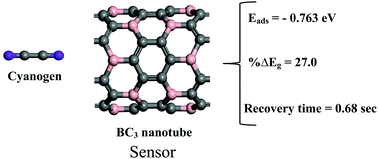Gas-sensing performance of BC3 nanotubes for detecting poisonous cyanogen gas: a periodic DFT approach
Abstract
In this research, the significant sensor properties of BC3 nanotubes (BC3NTs) for the detection of poisonous cyanogen gas are presented through periodic density functional theory (DFT) calculations. The most stable complex formed between cyanogen and the BC3NTs exhibited a calculated adsorption energy of −0.763 eV with a recovery time of 0.68 seconds at 298 K. Cyanogen gas is therefore detectable due to the appropriate recovery time under ambient conditions. The uptake of cyanogen gases prompted a substantial change of 27.00% in the band gap (Eg) of BC3NTs in the most sensitive complexes. The sensor is efficient because there is significant sensitivity and selectivity of the desired BC3NTs in detecting toxic cyanogen gas even in the presence of water, oxygen, and nitrogen molecules. The gas-sensing capacity of BC3 nanosheets (BC3NSs) toward cyanogen gas was also studied and compared with the BC3NTs. It was shown that BC3NTs are a more convenient and sensitive sensor as compared to BC3NSs for the detection of cyanogen in practical applications.



 Please wait while we load your content...
Please wait while we load your content...